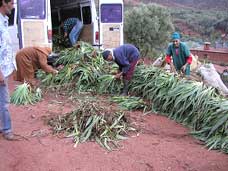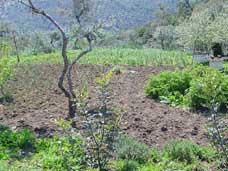|
Improving Livelihoods
The North Africa Biodiversity Programme aimed at improving the livelihood of local populations living around the Programme sites. A number of activities were specifically targeted to women. (see Women and Biodiversity section).
In each country, local populations cultivated medicinal plants and received training on cultivation and distillation techniques. They were then able to use the plant production for their own use or to sell it to herbalists thereby increasing their revenues. In Algeria, for example, three women-run farms committed to growing medicinal plants in their land, as a pilot project, and sold their entire crop to a local herbalist, providing a launching pad for rural development and empowerment of women. In Egypt, Bedouin communities established micro-nurseries on their land, focusing on the sustainable use of the plants. In some countries, plants, such as the caper tree and the iris in Morocco, helped increase revenues through commercialization, but also insured protection of soils against erosion.

In Morocco, the Programme aimed at increasing the revenues from the plants for local communities and managing them in a sustainable manner, by identifying an adapted methodology to valorize medicinal plants, organizing the commercialization of plants under the control of local communities in partnership with the Service Provincial des Eaux et Forêts, and identifying exploitation and cutting methods. Additional activities other than the cultivation of medicinal plants also took place, mainly in Morocco and Tunisia, helping to improve the livelihoods of local populations.
In Morocco, production of honey and fruits were another means of improving the revenues of the population. An interest group for honey was constituted in the village association, bee hives and maintenance products were distributed to families and demonstration sessions were organized. This activity created jobs linked to the maintenance, extraction and commercialization of honey. Two thousand fruit tree seedlings were also distributed and the population was assisted in their plantation. The pruning of the trees offered fuel for cooking and reduced the collection of wood in the forest, improving conditions for women, who have to walk long distances to collect wood.
Due to the technical, economic, ecological and social interest in the use of renewable resources, the programme also worked on promoting that and provided a solar water heater for the Mosque of the village of Tassa Ouirgane, which was using more than fifty kilos of wood per day to heat water. This also reduced pressure on surrounding woods and chores for women.
Finally, micro-credits were provided to local populations to help them develop ecotourism facilities, so that they could benefit from tourism and gain from the protection of their environment.
In Tunisia, the programme worked with 48 families living in and around the forest of the area of Rhim, in the northwest of Tunisia. Hundred wood-saving stoves were distributed to the families reducing wood consumption by 58%.

Hundreds of fruit trees were distributed to families for planting in their gardens with the aim of helping against soil erosion, providing nectar to bees during the difficult winter periods and providing beneficiaries with fruits easily sold on local markets. 5000m of metal fencing was provided to 39 family clearings, essentially to keep wild boars out of the gardens. This fencing economized 344 tons of wood consumption in the surrounding forest as it replaced traditional closures made from cut trees, shrubs and branches, which had to be replaced periodically. In order to improve revenues for families and reduce pressure on the vegetative cover from overgrazing by sheep and goats, animal husbandry was encouraged by the provision of bees, poultry and rabbits.
Three wells and three Majels, which are a kind of traditional tank designed to collect water rain, were built with the participation of the population, in order to improve water harvesting, facilitate access of women to water, and promote crop production.
|


